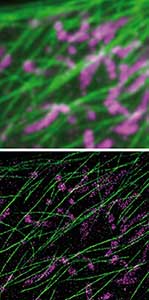BOSTON, Oct. 14, 2015 — A company spun out from Harvard University aims to provide life sciences researchers with a way to achieve subdiffraction imaging resolution using standard fluorescent microscopes.
Ultivue Inc. will commercialize imaging reagent technology developed at Harvard's Wyss Institute for Biologically Inspired Engineering. The reagents, called DNA-PAINT, are intended as a low-cost alternative to more specialized superresolution microscopy techniques.

The resolution ability of a single-molecule microscope (top) is compared to that of DNA-PAINT and Exchange-PAINT (bottom). Shown are
structures of thin microtubule fibers (green) that build a skeleton within cells and mitochondria (magenta). Courtesy of the Wyss Institute at Harvard University.
The techniques, described in Nature Methods (doi: 10.1038/nmeth.2835), use complementary DNA strands to attach fluorescent dyes to the objects to be visualized. The time the DNA strands stay connected can be tuned based on their nucleotide sequences. This controls the fluorescence, which allows targets to be localized with higher precision than would be possible by other means.
By using different DNA sequences to label distinct targets and applying the imager strands to one target at a time, many distinct targets can be imaged sequentially using only one dye and one laser source. The Exchange-PAINT variation lends itself to multiplexing that can visualize 10 and potentially up to 100 molecular species.
"We can now study many processes at a molecular level, such as changes in chromosomes or minuscule neuronal structures," said Peng Yin, Ultivue's scientific founder. "We also could determine molecular states of diseases in a more comprehensive fashion and with much greater detail, providing an enabling platform for digital pathology."
Yin is a core faculty member at the Wyss Institute and an associate professor of systems biology at Harvard Medical School.
Ralf Jungmann, a former postdoctoral fellow in Yin's lab who helped developed the technologies, is a cofounder. Former postdoctoral fellows Xi Chen and Mael Manesse will join the company as staff scientists.
Development of DNA-PAINT and Exchange-PAINT was funded by the National Institutes of Health, National Science Foundation and Office of Naval Research.